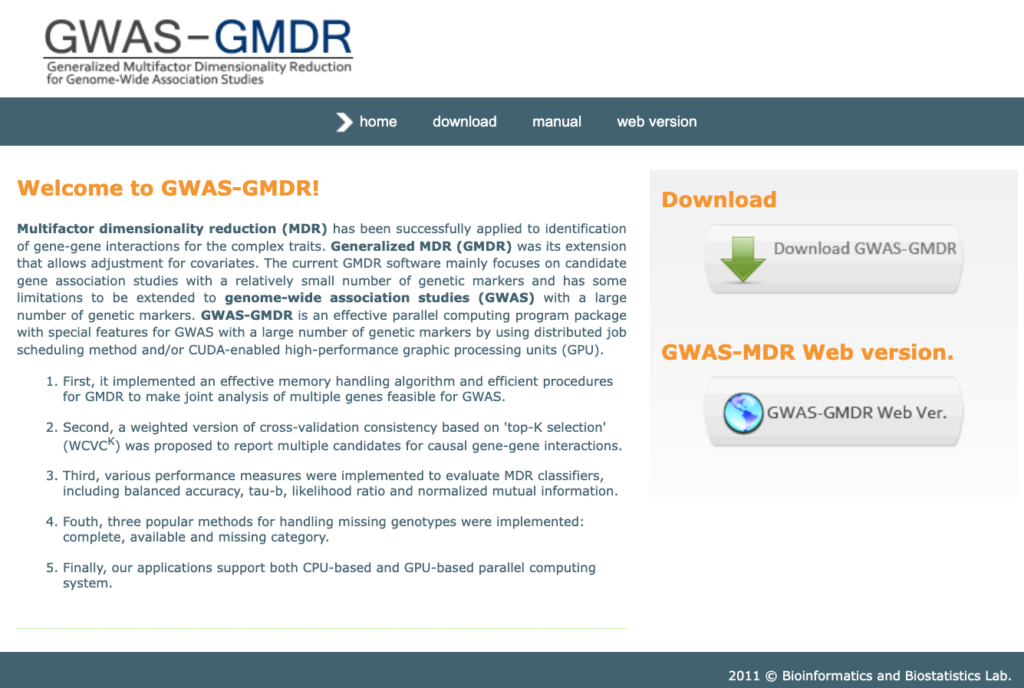Welcome to IGENT!
IGENT is an efficient algorithm for identifying genome-wide gene-gene interactions (GGI) and gene-environment interaction (GEI). IGENT supports two types of strategies to identify gene-gene interactions related with diseases in genome-wide scale. One is an exhaustive search approach for lower-order interactions such as 2nd order interaction, and the other is a stepwise selection approach for higher-order interaction. With tens of thousands of SNPs from thousands of samples, it is difficult to calculate higher-order interaction exhaustively because the computational burden is too heavy. IGENT provides a stepwise approach for higher-order interactions.
Manual
Run IGENT
igent --in [input file] --out [output file] --order [order]
ex) igent --in sample.txt --out result.csv --order 2
[Parameter]
- –in : input file path + name
- –out : result file path + name
- –order : combination order (1,2,3,4,…. or 1-3, 2-5) (default : 2)
- –mode : exhaustive search or stepwise search (exhaustive, stepwise) (default : exhaustive)
- –shuffling : shuffling (0 : not shuffling 1: shuffling) (default : 0)
Download GWAS-GMDR
Current version
IGENT is currently at Version 1.5 (04/19/2017)
Download
> download IGENT
Hi-Mini : A program for identification of high-order interaction
Hi-Mini allows an efficient high-order interaction analysis in genome-wide association studies using multifactor dimensionality reduction. It is a program based on character user interface (CUI), hence it does not provide graphical user interface. In order to use Hi-Mini, an understanding on command-line interface is required.
Download
Hi-Mini supports multiple operating systems, including Windows, various Linux distributions and Mac operating system. Downloading Hi-Mini is possible via below links.
Input file
Hi-Mini can load various types of SNV dataset file, including PED file, Binary PED file and transposed PED file. For the details of above file formats, please refer PLINK website. The input option should be –bed for Binary PED file, –ped for PED file, and –tped for transposed PED file, respectively. Note that the phenotype field of input file should encoded in 1 for control and 2 for case.
Usage
himini –bed sample.bed : Assigns sample.bed as an input
himini –bed sample.bed –hmdr 8 –mdr –order 2 –top 1000 : Search up to 8th-order interaction using Hi-Mini, based on top 1000 results from second-order exhaustive search
himini –bed sample.bed –hmdr 8 –mdr –order 2 –top 1000 –hmdrprior top1000_order2.txt : Search up to 8th-order interaction using Hi-Mini, based on top 1000 results from pre-computed second-order exhaustive search
In case of third example, it is required to analyze second-order exhaustive MDR using cuGWAM or other software. The prior file of third example should consists of N lines for top N search, and each line should consists of P+1 columns. In each line, the first P elements are marker IDs in the dataset, and the last element should be balanced accuaracy of that interaction pair. Note that this P should equivalent to the parameter assigned in –order. For detailed instructions on cuGWAM, refer this page.
Fuzzy MDR
Introduction
This fold includes R source files for implementation of the numerical study in the manuscript submitted to BMC Genomics, 2016, titled “A novel multifactor dimensionality reduction method based on fuzzy set theory for detecting gene-gene interaction”.
Usage
The following functions are implemented in the source code:
mdr.fuzzycv —— Implements Fuzzy MDR with cross-validation
mdr.fuzzy —— Performs Fuzzy MDR over a specified set of combinations of variables/loci
mdr.fhr ——Estimates the accuracy of an Fuzzy MDR model given high-risk/low-risk status
Example
mdr.fuzzycv(data, K=2, cv=10, ratio = NULL, genotype = c(0,1,2),memb=”linear”,criteria_OR=2,weight=1 ) memb= “original” -> original MDR “linear”-> linear membership “sigmoid”-> sigmoid membership
Download
The above contents including the R code and sample dataset can be download from the below link.
R code download Sample dataset download
Fuzzy set based approach to generalized multi-factor dimensionality reduction analysis of gene-gene interactions (FGMDR)
Introduction
This method is fuzzy generalized multifactor dimensionality reduction (FGMDR) method as an extension of GMDR method to detect gene-gene interactions associated with disease using fuzzy set theory. Details of Fuzzy MDR is explained in the following paper. More details of FGMDR will be updated as soon as published.
Citation
Jung, H.-Y., et al. (2016) A novel fuzzy set based multifactor dimensionality reduction method for detecting gene-gene interaction, Computational Biology and Chemistry.
Example
#glm fitting for residual calculation with equation as class~covariates form
fit_model <- glm(temp_data[,n]~temp_data[,n-1], data= temp_data, family = binomial(link = "logit"))
#standard residuals for FGMDR
temp_data$res<-residuals(fit_model, type="response")
#data transformation, SNPs(9:24) and residuals(8)
data_FGMDR <- temp_data[,c(9:24, 8)]
#run FGMDR with 2-locus, 0.5 threshold and 10-fold cross validation
res_2_2<-FGMDR(data_FGMDR, 2, 0.5, 10)
#drawing result figure
plot_FMDR(res_2,2)
Download
The above R code be download from the below link.
Download
A novel fuzzy set based multifactor dimensionality reduction method for detecting gene-gene interaction (EFMDR)
Introduction
This method is an extension of Fuzzy MDR without tuning parameters. Details of Fuzzy MDR is explained in the following paper. In this EFMDR method, the membership degree is estimated by the maximum likelihood estimator of the proportion of cases(controls) in each genotype combination. More details of EFMDR will be updated as soon as published.
Citation
Jung, H.-Y., et al. (2016) A novel fuzzy set based multifactor dimensionality reduction method for detecting gene-gene interaction, Computational Biology and Chemistry.
Example
# an example of 2-locus analysis using MDR sample data library(MDR) data("mdr1")
res<-EFMDR(mdr1,2)
plot_EFMDR(res,2)
Download
The above R and CPP code be download from the below link.
Download R code
Download CPP code zip


